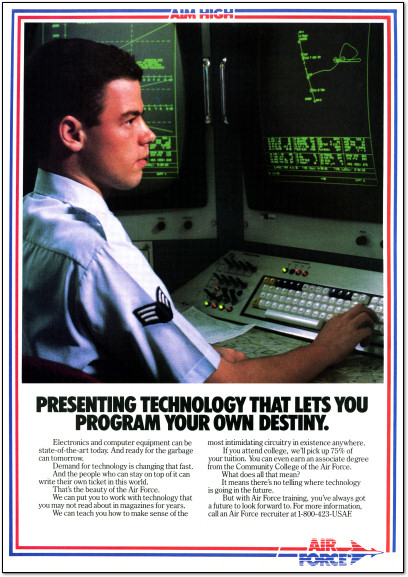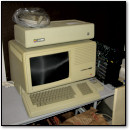Archive for the 'Technology Commentary' Category
[ Retro Scan of the Week ] Sharp Pocket Locker
Monday, December 5th, 2011 Two teen girls compare notes on vampires that attend their high school.
Two teen girls compare notes on vampires that attend their high school.
Ah, the dedicated electronic pocket organizer — an ever-present, seemingly useful device for want of a market.
Since the early 1980s, electronics manufacturers have produced pocket-sized computer gadgets that store databases of phone numbers, addresses, calendar appointments, and not much else. These electronic organizers reached their peak (in terms of number of devices in the market) in the mid-1990s. At that time, the technology involved became cheap enough to market to kids.
Despite manufacturers’ best efforts, such devices have continuously failed to gain widespread use for a simple reason: none have demonstrably improved upon the paper address book. Not even the socially-hungry teen girl market, as targeted by Sharp in this 1995 ad for the Pocket Locker, could push them into the mainstream.
It was only when manufacturers rolled electronic organizer functionality into a more general-purpose device (think palmtop computer, PalmPilot) that the idea of electronically maintaining personal contact records in a mobile setting took off. Address books, calendars, and phone databases became separate programs that lived in a larger ecosystem of applications that could be run on the device.
Most palmtop computer-style PDAs offered significant advantages over the paper organizer. They synchronized with PCs to back up information, and they could use the stored data in conjunction with other programs for more useful effect — for example, you could actually email someone directly from a record stored in your digital address book.
Contrast that experience to the dedicated pocket organizer model, where the the information you entered became trapped in a tiny plastic box with a crummy display and a kludgy interface that would lose its memory if its batteries ran out.
Today, the organizer-as-software clearly won over dedicated units, and anyone with a mobile phone now carries an organizer software suite in their pocket. It’s only one of many functions that cellphones have absorbed on their quest to become the ultimate multipurpose pocket device.
Discussion Topic of the Week: Have you ever used a dedicated electronic pocket organizer device? Tell us about it.
You Know It’s an Old Website If…
Wednesday, November 23rd, 2011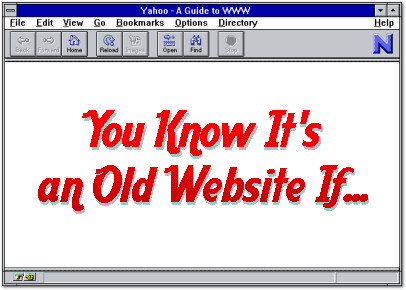
Just a little while ago on Twitter, I started spouting out some one liners, Jeff Foxworthy style, about how you know if a website is old. I love coming across old websites, so it’s fun to spit these out.
I can’t guarantee that they’re funny, but I think they’re at least amusing. People liked them enough that I decided to post my lines here and ask you guys to continue the list. I may add more to it over time.
- You know it’s an old website if…
…every image on the site rotates. - You know it’s an old website if…
…they refer to AltaVista in the present tense. - You know it’s an old website if…
…you found it through a web ring. - You know it’s an old website if…
…it says “Best viewed in IBM WebExplorer.” - You know it’s an old website if…
…your browser complains that there’s no MIDI plug-in installed. - You know it’s an old website if…
…it forces you to enter the site through a splash page. - You know it’s an old website if…
…it asks you not to hotlink the GIF images. - You know it’s an old website if…
…every single link on the page ‘404s. - You know it’s an old website if…
…the owner claims it’s “under construction.” - You know it’s an old website if…
…it brags about having 1,000 hits.
Now it’s your turn. Add your one-liners in the comments below.
[ Retro Scan of the Week ] Asimov’s Pocket Computer
Monday, September 26th, 2011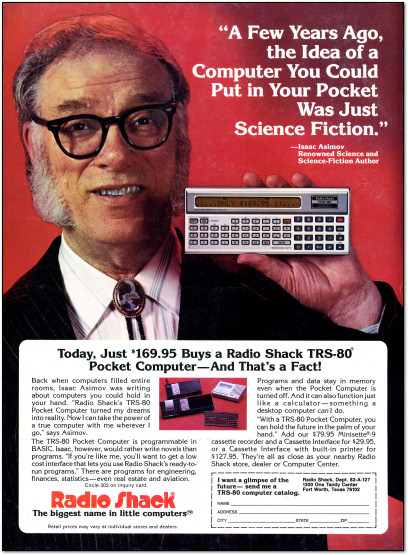 “It’s so small I nearly swallowed it.”
“It’s so small I nearly swallowed it.”
The TRS-80 Pocket Computer was an amazing little gadget. This 1980 calculator-sized computer packed a full QWERTY keyboard and the BASIC programming language built in. The ability to program BASIC on such a tiny pocket machine was incredible in an age when few calculators were programmable at all, and the ones that were required arcane rituals to program.
I used this exact model myself in high school on some math tests to perform some trigonometry equations in a BASIC program I wrote. Even though that was in the mid-late 1990s, the Pocket Computer seemed so futuristic that the teacher had no idea it was possible. Even today, the Pocket Computer remains incredibly useful for certain tasks. That’s an amazing thing to say about a device released in 1980.
Discussion Topic of the Week: What’s the smallest computing device you owned prior to the year 2000?
The Beleaguered IBM PC in History
Friday, August 12th, 2011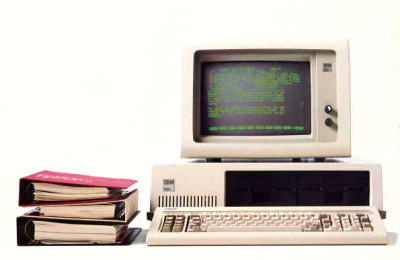
From the 1990s until very recently, the press has been generally unkind to the achievements of the first IBM PC. Due to the PC platform’s utter dominance of the personal computer market, popular accounts of personal computer history commonly paint IBM as the slow, lumbering, clueless enemy while cheering on spunky underdogs like Apple. I’m not even going to cite specific examples: Google “computer history.” Read. You will see it.
But that perspective is not fair at all. IBM truly pulled off something smart, savvy, and remarkable in designing the IBM PC 5150 (and the machines that followed it, into the PS/2 era). With the 5150, a team of 12 people took the machine from concept to shipping product in less than a year. And yet many focus on how IBM supposedly lost its way.
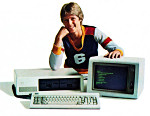 Much ballyhoo has been made, for example, about how IBM lost its grip on the PC’s direction as clones flooded the market. From a different perspective, that runaway-freight-train-of-a-platform is a success story for IBM.
Much ballyhoo has been made, for example, about how IBM lost its grip on the PC’s direction as clones flooded the market. From a different perspective, that runaway-freight-train-of-a-platform is a success story for IBM.
While Big Blue lost market share to clone manufacturers, you have to keep in mind that IBM’s percentage shrank as the market size exploded. IBM fostered a rich PC standard that it kept reaping until it sold its PC division to Lenovo in 2004. IBM may not have kept steering the ship, but they sure made a lot of money in the cargo hold.
And if you think IBM’s influence on the PC standard ended in the early 1980s, think again. Real history is not so cut-and-dry. The PS/2 era (which dawned in 1987) gave us stalwarts like the PS/2 mouse/keyboard ports and, ah yes, that minor display technology called VGA. You can also thank the 1990s ThinkPad line for its part in streamlining the modern laptop.

The popular narrative of IBM vs. Apple in the 1980s, with its strong contrasts of Good vs. Evil and Hero vs. Villain was largely a creation of Apple’s marketing department. The image of Apple’s David verses IBM’s Goliath got repeated so many times that the press started using the supposed rivalry as the basis of dramatic stories. Humans need narratives to make sense of history, and writers have forced the PC market story into that archetypal mold.
Sure, IBM and Apple competed for dollars — and they may have even done it vigorously — but business is business. It’s not swashbuckling. The first thing you learn when actually studying computer history (i.e. interviewing folks) is that just about no one involved in creating these products thinks they were doing something so incredibly amazing that it should be turned into a movie. They were just doing their jobs, developing good products, and trying to make money like everyone else. When the project was over, they moved on to other things. That story is incredibly boring if you don’t dramatize it.
By using the IBM PC for a week for a recent article, I learned firsthand that the original PC really was an amazing machine for its time. It wasn’t just a generic box that happened to have an IBM logo on it, as some people argue. Sure, it didn’t have flashy graphics or a GUI, but it was solid, reliable, well-designed, and it was definitely the most qualified personal computer for getting work done in 1981. There is a reason it became a standard, after all — everyone imitated it, and they imitated it because it was amazing.
A Few Thoughts on the IBM PC’s Birthday
Friday, August 12th, 2011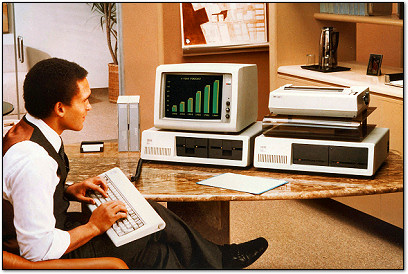
When the IBM PC turned 20 back in 2001, I said to myself, “Really? It’s that old already?” I was honestly surprised. Now that the PC platform is 30 (as it just turned today), that age seems obvious. (“Thirty, you say? Sounds about right.”)
Computer technology has come a long way since 1981, and the last 10 years in PC land have been just as eventful as the first 20. We’ve seen the Internet’s social explosion, juice-sipping Intel Atom processors, netbooks, powerful sub-$500 desktop PCs, the iPhone, the rise of the consumer tablet computer, and — oh yeah — Macs are more like IBM PCs than ever, living their lives in an x86 world. PCs aren’t necessarily beige metal desktop boxes anymore (as they still were in 2001) — in fact, folks are more likely to buy a thin laptop computer in 2011.
My point, I guess, is that I’m glad the IBM PC is 30. It is probably time to move away from the paradigm set in motion by the Wintel duopoly in the 1980s, although we may never fully escape it on the desktop. That is not necessarily a bad thing, but it’s time to try some new ideas in personal computing. And we are. With non-x86, non-Windows tablets and smartphones as influential as they are now, the winds of computing seem to be blowing 180 degrees away from the Intel-Microsoft PC platform. It’s exciting to think where those winds will take us in the future.
Do You Use A Vintage Computer for Real Work?
Wednesday, June 8th, 2011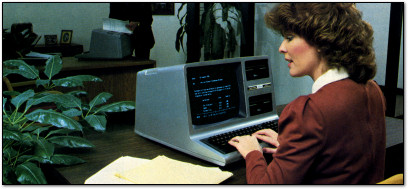
Does anybody out there still use an old, obsolete computer for real work?
For example, I’ve heard tales of TRS-80 Model 100 laptops powering road-side traffic signs, and of companies relying on Apple IIs with custom BASIC software from the 1980s. Some firms still keep ancient mainframes with important databases running deep in the basement, and while others have not yet upgraded from Windows 3.1.
I’m not talking about hobbyist vintage computing here. I’m talking about an individual or company who still uses an old, old machine to get things done. Maybe you’ve spotted a case of this while out and about, or perhaps you know someone who won’t let go of their trusty PC. Obviously, the older the computer, the more interesting the story.
If you guys know of any instances of this, I’d love to hear about them in the comments below! I’ll compile the best stories in a future blog post.
[ Retro Scan of the Week ] Rexall Typewriter Paper
Monday, March 28th, 2011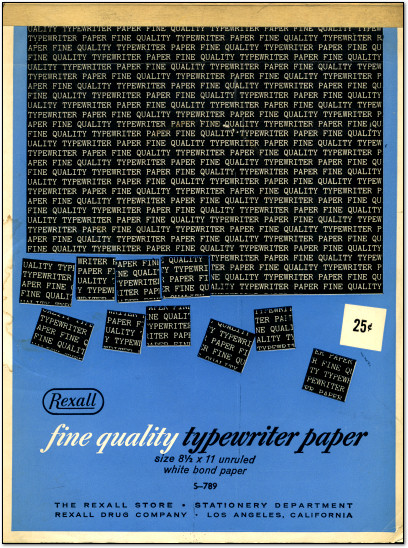 Rexall Fine Quality Typewriter Paper
Rexall Fine Quality Typewriter Paper
I found this pad of 8.5″ x 11″ Rexall typewriter paper in a pile of my parents’ old documents. It immediately struck me as interesting because typewriter paper is not something you’d typically find on sale in a drug store these days.
Why? Well, computers, my boy. They obliterated the typewriter market decisively in the early 1990s. People found the ease of word processing on an electronic screen (especially in the post-Macintosh GUI era) much more flexible, powerful, and convenient than the comparatively cumbersome practice of using a typewriter.
Some years ago I recall reading that certain old-school writers still swear by typewriters for clarity of thought and purity of purpose. There’s something to that philosophy, as the modern multi-tasking operating systems we have today are extremely distracting for serious work. Maybe computer single-tasking should come back in vogue.
Discussion Topic of the Week: When’s the last time you used a typewriter? Tell us about the occasion.
The Eerie World of Abandoned Computers
Tuesday, March 15th, 2011Up now on PCMag is a slideshow I created about derelict computers and urban exploration. Here’s an excerpt from the introduction:
In the heart of civilization lie places abandoned. For whatever reason, people retreat from these spaces entirely, leaving behind unintentional time capsules filled with objects and equipment from another era, including computers.
You’ll find a number of abandoned vintage computers included in the piece, so I thought VC&G readers might enjoy it.
I’d like to give special thanks to all the photographers who let me use their amazing photos in the slideshow. It’s a shame the images don’t show up bigger in the layout like those in my older PCMag slideshows (not my choice). Even with smaller images, the emotional impact of seeing decaying and abandoned technology is still there.
Have you ever encountered a totally abandoned computer left somewhere to rot for all time? Tell us about it.
The History of Stereoscopic 3D Gaming
Friday, March 4th, 2011If you’ve ever had half a heap’a wunderin’ about the history of stereoscopic displays in the computer and console gaming realm, mosey on over to PC World to check out my latest slideshow. There you will find 21 lovingly-crafted slides that tell the long and varied story of 3D stereoscopy in video and computer games.
Writing about video game history for a computer-centric publication has its ups and downs. While the publication is top-notch, sometimes I think video game fans miss out on the best of my work. So if you think you know someone who might like this piece, please spread the word.
After this yet-another lengthy visual article, I’m thinking about wrapping it up in regards to epic slideshows. Sure, I’ll still do slideshows, just not ones so very, very long and involved.
After you’re done checking it out, I’d love to hear about your personal history with stereoscopy in video and computer games.
And don’t forget: the Nintendo 3DS comes out in the US on March 27th.
